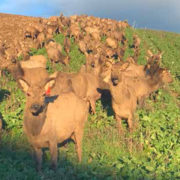On-farm proof for breeding values will soon get real
by Phil Stewart, Deer Industry News Editor
Three commercial venison producers will soon be starting to see the impact of breeding values (BVs) within their own herds when the 2019 fawning season gets under way.
EACH FARM IS using a pair of sire stags with contrasting BVs and has mated them to approximately equal numbers of hinds. The progeny will be DNA matched to the sires and measured as they grow. To highlight the impact of genetic merit on their progress and remove environmental effects, progeny from both sires will be run in the same conditions within each farm.
The trial, while not as rigorous as one that you’d see in highly controlled conditions on a research farm, has the advantage of showing the impact of BVs in an everyday commercial situation.
In the August/September Deer Industry News, we profiled David Seifert, who is testing the impact of BVs from two sires in challenging conditions in the central North Island. In this article we talk to the two other farmers involved in the exercise: Duncan Humm and John Hamilton.
Carluke Deer
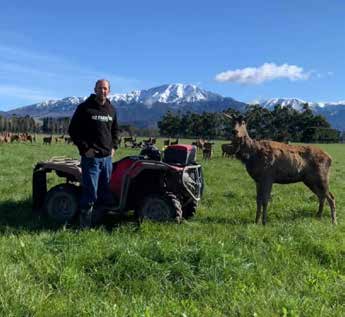
Duncan Humm: Keen to see how the contrasting BVs for the two sires are
expressed in their progeny in a commercial venison situation.
Duncan and Lorna Humm run 170 English red breeding hinds at Carluke Deer on 43 hectares of flats at Mount Somers in Canterbury, with a small number of velvetting stags and stud velvetting hinds that are part of a separate share farming operation.
Breeding deer in a fairly restricted area that is all flat presents its challenges and the breeding season can be a “game of chess” to keep mating mobs separated says Duncan Humm.
Humm admits that he is a little sceptical about BVs, and is as influenced by an animal’s phenotype (results of the interaction between its genetic traits and an animal’s environment) as he is by their genotype (their genetic traits alone). He likes to see how the sire itself grows and is a keen observer of animal performance in the field. “In the past I’ve bought animals that looked good on paper, but didn’t deliver.”
He is, however, keen to see how the progeny from two stags with contrasting growth BVs will perform in their environment. The two used for this exercise are leased from Melior (formerly Deer Improvement) and have contrasting BVs. On weaning weight (WWT) there is a 6.3kg difference, which expands to a 13.3kg difference by the time we get to weight at 12 months (W12). (The two stags are +20.6kg and +33.9kg on that trait, see Table 1.)
Conception rates are not an issue for the Humms, with scanning for young and mixed age hinds regularly in the 95–100 percent range. The two stags used in this exercise each looked after 50–60 hinds. Humm says all of the first fawners were scanned in fawn this year, and about 98 percent of the mixed age hinds.
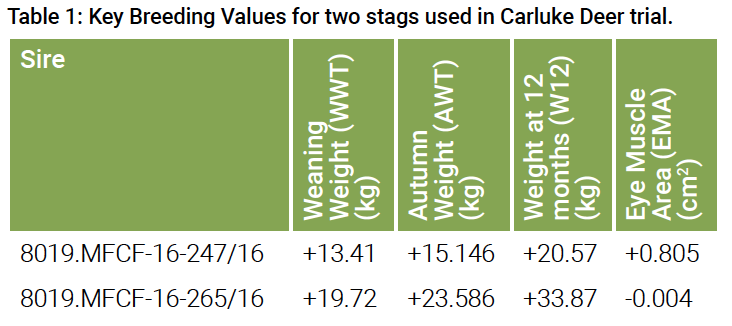
Unlike many who are targeting a compact breeding hind in the 120–125kg mature weight range, Duncan Humm said they favour a larger hind, more in the 130–140kg range. “In our environment, big hinds grow big fawns and if it does get dry during lactation, the larger hinds are better able to keep feeding their fawns. I used to cull the really big hinds – what was I thinking!”
He is also interested in temperament and conformation – mainly well-muscled hindquarters. Humm usually retains between 20–30 yearling hinds each year as replacements. “If they can make 100kg by January then they’re eligible to stay,” he says. Hinds that fail to raise a fawn are also likely to be culled. The Humms are well aware that it’s not wise to focus too much on one particular trait, and that health and nutrition are vital cogs in the deer growth machine, as are traits such as eye muscle area. On the feeding side they have a regular programme of pasture renewal linked to their crops of swedes, kale and fodder beet. Humm says they won’t persevere with fodder beet but in pursuit of a more regenerative approach are looking to establish mixed swards including species such as oats, triticale, vetch, lupins, kale and rape. In addition to the regularly renewed pastures (the ‘oldest’ has been in the ground only six years), Humm says there are some very old pastures. Some are up to 100 years old but still produce well. Looking at the upcoming trial with the next crop of fawns, Humm is looking forward to seeing how the progeny from the two stags perform.
Fearnvale Farm
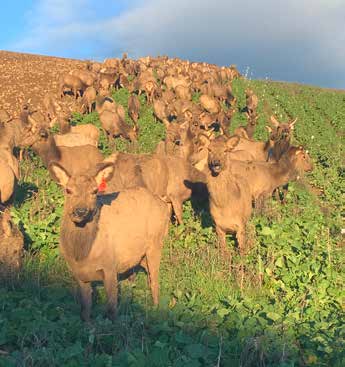
Some of the wapiti cows being used in the BV trial on the Hamiltons’
Fearnvale farm, tucking into swedes on a break.
John and Tash Hamilton run 750 elk/wapiti and 1,300 sheep on their 280 hectares (180 ha deer fenced) of rolling country near Winton in Southland.
John Hamilton says they have just started taking a closer look at BVs and they purchase their sires, so the breeding value proof trial was an ideal opportunity to gauge just what impact they could make on their venison production.
They are members of the Elk/Wapiti Southland Advance Party and in the early days of the group they highlighted a desire to grow more meat and velvet per hectare and improve reproductive performance. One strategy they trialled with some success was to hold groups of animals back from slaughter for 20 or 40 days to balance the costs (additional feed, falling schedule) against the benefits (increased carcass weight, more spiker velvet). On balance, the exercise showed a good net benefit, giving the Hamiltons more options when seasonal and market conditions allow.
One objective they highlighted earlier was greater use of BVs recorded on Deer Select, so John was happy to help out with the BV proof trial when the opportunity arose. They bought two wapiti bulls from Tikana. As with the sires used by the Humms, the BVs for growth for the two sires steadily widen with time from weaning weight (5.8kg apart) through to weight at 12 months, where there is a 12.5kg difference (Table 2). The superior sire also has a slight advantage on the eye muscle area BV.
Hamilton says the sires each mated groups of 40 mixed age cows of average weight with excellent results – only one dry cow out of the two groups.
“It wasn’t any hassle setting up the trial. I’m interested to see how these BVs work for us and it might also give us a push to get some genetic improvement in our herd.
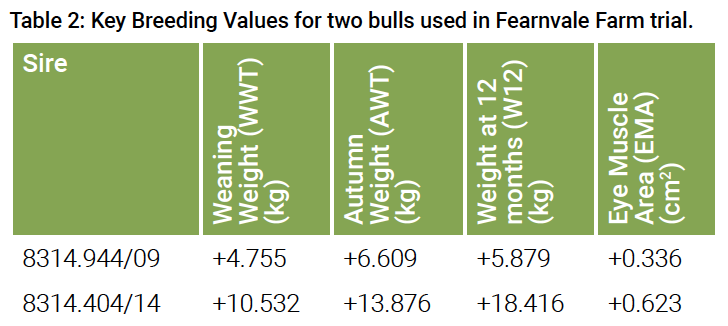
” He says set stocking happens in late October, with calving under way by early November.
- As the progeny from the three on-farm breeding value proof trials grow, Deer Industry News will carry updates on how they are progressing and, in particular, how their progress measures up against the BVs of their sires.

